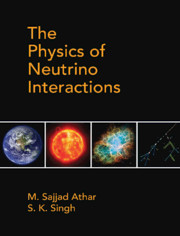Book contents
- Frontmatter
- Dedication
- Contents
- List of Figures
- List of Tables
- Preface
- Acknowledgments
- Chapter 1 Neutrino Properties and Its Interactions
- Chapter 2 Relativistic Particles and Neutrinos
- Chapter 3 Quantization of Free Particle Fields
- Chapter 4 Interacting Fields and Relativistic Perturbation Theory
- Chapter 5 Phenomenological Theory I: Nuclear β-decays and Weak Interaction of Leptons
- Chapter 6 Phenomenological Theory II: Weak Decays of Hadrons
- Chapter 7 Gauge Field Theories and Fundamental Interactions
- Chapter 8 Unified Theory of Electroweak Interactions
- Chapter 9 Neutrino and Electron Scattering from Point Particles
- Chapter 10 Neutrino scattering Cross Sections from Hadrons: Quasielastic Scattering
- Chapter 11 Neutrino Scattering from Hadrons: Inelastic Scattering (I)
- Chapter 12 Neutrino Scattering from Hadrons: Inelastic Scattering (II)
- Chapter 13 Neutrino Scattering from Hadrons: Deep Inelastic Scattering
- Chapter 14 Weak Quasielastic v(⊽)-nucleus Scattering
- Chapter 15 Inelastic Scattering of (Anti)neutrinos from Nuclei
- Chapter 16 Deep Inelastic Scattering of (Anti)neutrinos from Nuclei
- Chapter 17 Neutrino Sources and Detection of Neutrinos
- Chapter 18 Neutrino Mixing and Oscillations
- Chapter 19 Neutrino Astrophysics and the Synthesis of Elements
- Chapter 20 Neutrino Interactions Beyond the Standard Model
- Appendices
- Appendix A Lorentz Transformation and Covariance of the Dirac Equation
- Appendix B Cabibbo Theory
- Appendix C Some Properties of Pauli and Dirac Matrices and Spin Density Matrices
- Appendix D Leptonic and Hadronic Tensors
- Appendix E General Expression for the Total Scattering Cross Section and Decay Rates
- Appendix F Expressions of N(q2), the Coefficients of the Polarization Observables
- References
- Index
Chapter 10 - Neutrino scattering Cross Sections from Hadrons: QuasielasticScattering
Published online by Cambridge University Press: 22 May 2020
- Frontmatter
- Dedication
- Contents
- List of Figures
- List of Tables
- Preface
- Acknowledgments
- Chapter 1 Neutrino Properties and Its Interactions
- Chapter 2 Relativistic Particles and Neutrinos
- Chapter 3 Quantization of Free Particle Fields
- Chapter 4 Interacting Fields and Relativistic Perturbation Theory
- Chapter 5 Phenomenological Theory I: Nuclear β-decays and Weak Interaction of Leptons
- Chapter 6 Phenomenological Theory II: Weak Decays of Hadrons
- Chapter 7 Gauge Field Theories and Fundamental Interactions
- Chapter 8 Unified Theory of Electroweak Interactions
- Chapter 9 Neutrino and Electron Scattering from Point Particles
- Chapter 10 Neutrino scattering Cross Sections from Hadrons: Quasielastic Scattering
- Chapter 11 Neutrino Scattering from Hadrons: Inelastic Scattering (I)
- Chapter 12 Neutrino Scattering from Hadrons: Inelastic Scattering (II)
- Chapter 13 Neutrino Scattering from Hadrons: Deep Inelastic Scattering
- Chapter 14 Weak Quasielastic v(⊽)-nucleus Scattering
- Chapter 15 Inelastic Scattering of (Anti)neutrinos from Nuclei
- Chapter 16 Deep Inelastic Scattering of (Anti)neutrinos from Nuclei
- Chapter 17 Neutrino Sources and Detection of Neutrinos
- Chapter 18 Neutrino Mixing and Oscillations
- Chapter 19 Neutrino Astrophysics and the Synthesis of Elements
- Chapter 20 Neutrino Interactions Beyond the Standard Model
- Appendices
- Appendix A Lorentz Transformation and Covariance of the Dirac Equation
- Appendix B Cabibbo Theory
- Appendix C Some Properties of Pauli and Dirac Matrices and Spin Density Matrices
- Appendix D Leptonic and Hadronic Tensors
- Appendix E General Expression for the Total Scattering Cross Section and Decay Rates
- Appendix F Expressions of N(q2), the Coefficients of the Polarization Observables
- References
- Index
Summary
Introduction
In the last chapter, we have discussed how to calculate the cross sectionsfor the scattering of two point-like particles. Now the question arises,what happens when an electron interacts with a charge which is distributedin space like the one shown in Figure 10.1. The standard technique tomeasure the charge distribution and get information about the structure ofthe hadron is to measure the differential/total scattering cross sections ofelectron with a hadron and compare it with the cross section of electronscattering with a spinless (J = 0) point target (known asMott scattering cross section). The ratio of these two is generallyexpressed as
where F(q2), in literature, isknown as the form factor. This accounts for the spatial extent of thescatterer. F(q2) not only tellsabout the distribution of the charge in space but using it, one can estimatethe size of the target particle as well as its charge distribution anddensity of magnetization. Thus, for an extended charge distribution, theprobability amplitude for a point-like scatterer is modified by a formfactor.
Physical Significance of the Form Factor
Consider the elastic scattering of a “spinless” electron from astatic “spinless” point object having charge. In the Bornapproximation, where the perturbation is assumed to be weak, the scatteringamplitude is written as
where and are the wave functions of the initial and final electron withmomentum and, respectively. These waves are assumed to be plane waves suchthat
Instead of a point charge distribution, if we assume an extended chargedistribution with normalization, then the potential felt by the electronlocated at is given by
where is the maximum range of the charge distribution. The scatteringamplitude modifies to
Assuming, which leads to,
The term in the square brackets on the right-hand side of Eq. (10.6) is knownas the form factor, which is nothing but the Fourier transform of the chargedensity distribution, given as
In field theory, if we consider the scattering of a spin electron from anexternal electromagnetic field (shown in Figure 10.2), the electromagneticfield in the momentum space is written as
- Type
- Chapter
- Information
- The Physics of Neutrino Interactions , pp. 385 - 424Publisher: Cambridge University PressPrint publication year: 2020



